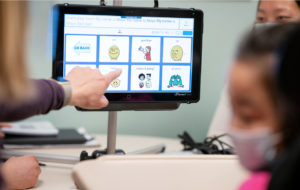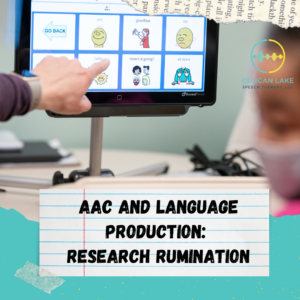When it comes to AAC, many, MANY myths exist (see this Facebook post). By far, the one I hear the most often is that AAC will become a crutch and the person using the AAC system will become reliant on the system and not talk.
This week, I read an article titled “Communication interventions for minimally verbal children with Autism: Sequential multiple assignment randomized trial” by Kasari, Kaiser, Goods, Nietfeld, Mathy, Landa, Murphy, & Almirall (2014). This team decided to investigate what, if any, affect AAC had on a non-verbal kiddo’s language production.
Let’s break it down!

Purpose: To investigate the effect of speech-language therapy involving a speech-generating device (SGD, a form of AAC) on spontaneous communication in minimally-verbal children with ASD.
Participants: 61 minimally verbal children with ASD ages 5-8 who had no other major medical conditions. Minimally verbal in this study means that the the kiddo produced 20 or less spontaneous different words in a 20 minute monitoring period.
How’d they do it: The kiddos were broken up into two groups: one group receiving the intense behavioral/prelinguistic therapy only and one group receiving the intense behavioral/prelinguistic therapy PLUS the use of a speech-generating AAC device. In the first 12 weeks, all kiddos received two, 1 hour sessions of therapy a week. In the second 12 week session, therapy varied based on how the kids responded (increased intensity, stayed the same, etc.). Some kiddos that didn’t have an AAC device initially were given a speech-generating AAC device based on their performance in the first 12 weeks.
Results: The group that started with the behavioral/prelinguistic therapy with a speech-generating AAC device showed much better improvements in spontaneous language production relative to the group that didn’t use an AAC device. Overall, the group with behavioral/prelinguistic therapy with a speech-generating AAC device DOUBLED their overall spontaneous language after 24 weeks of treatment! WOAH! Additionally, the kiddos that had the device right away produced more spontaneous language than the kiddos who received it later based on their first 12 week performance.
What does this mean?
Providing a means of alternative communication coupled with behavioral/linguistic therapy can actually INCREASE a kiddo’s language output. Providing the AAC later may not be as effective in helping the child produce language. In other words, as soon as a need arises, AAC must be started for the individual to achieve their highest language-output potential.
…thus debunking the “AAC as a crutch” myth.
***
Kasari, C., Kaiser, A., Goods, K., Nietfeld, J., Mathy, P., Landa, R., Murphy, S., & Almirall, D. (2014). Communication interventions for minimally verbal children with autism: A sequential multiple assignment randomized trial. Journal of the American Academy of Child & Adolescent Psychiatry, 53(6), 635-646.





Hey there, I appreciate you posting great content covering that topic with full attention to details and providing updated data. I believe it is my turn to give back, check out my website Autoprofi for additional resources about Car Purchase.